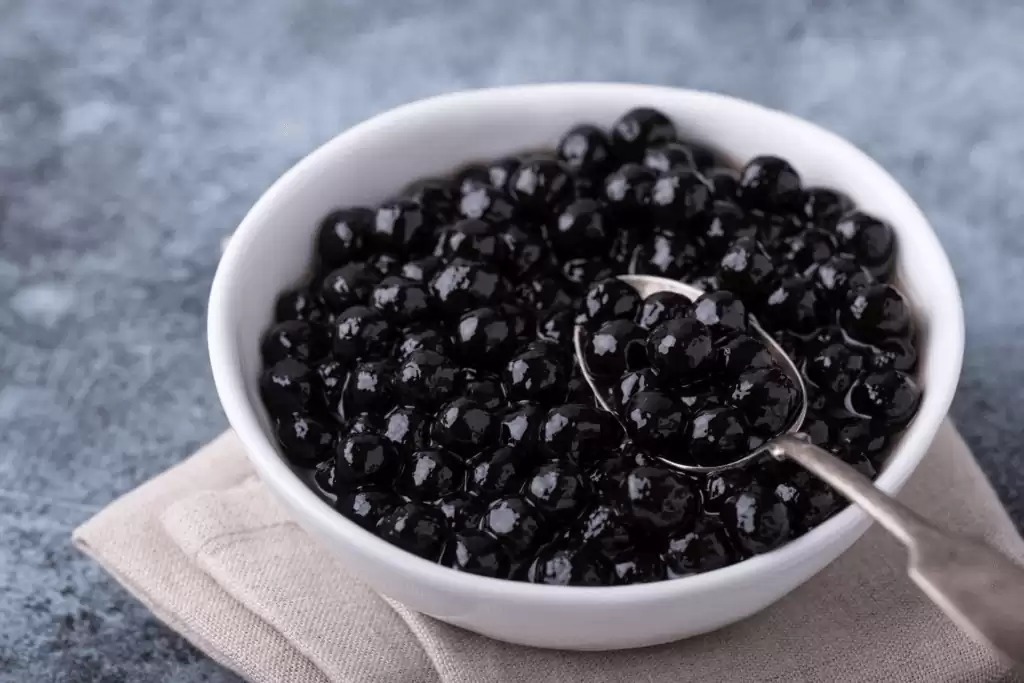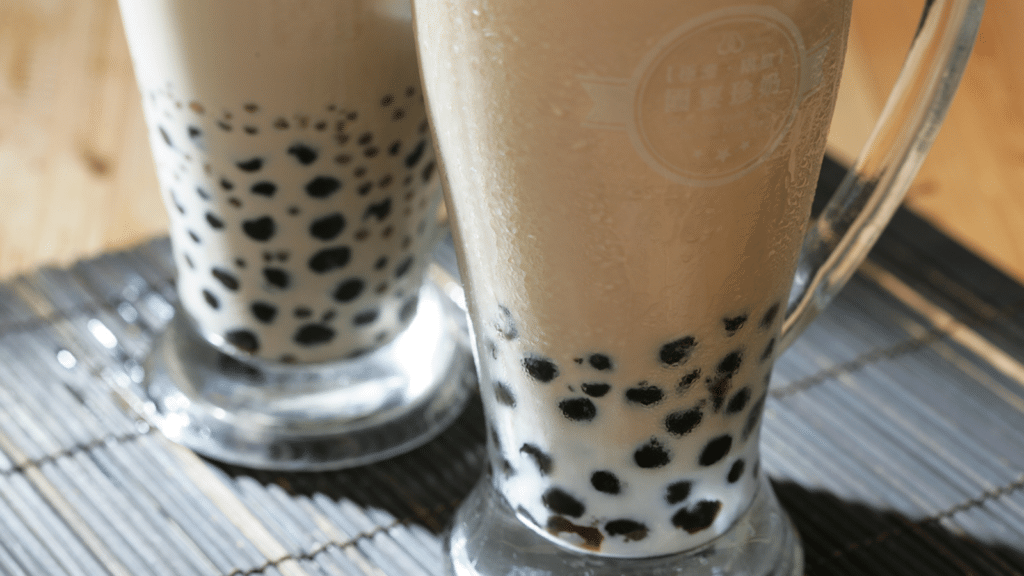Wouldn’t it be great if your boba pearls could be customised to your liking? Would you like to make sure that your drink does not contain any allergens or harmful components? Making it at home has never been easier.
With its burst of fruity goodness, popping boba is the perfect topping for your bubble tea. In contrast to tapioca pearls, it consists of colourful fruit juices dipped in a dessert pearl form. In addition, you can also make them at home with the whole family as it is a fun – and addictive – activity. At the end of the article, you’ll be provided with delicious popping boba as well as an introduction to the world of food science.

What is a popping boba?
There is no doubt that most bubble tea lovers have tasted this tasty treat at some point in their lives. This jelly-like ball breaks when pressed or bitten due to its thin skin. This kind of pearl is usually made with fruit juice as the base. It is also possible to use black and green tea as bases or even coffee. But what is it about its texture that makes it so addictive?
The texture is created by sodium alginate and calcium salt, both food additives. In order for the popping boba to have the perfect poppable mouthfeel, these additives are crucial. Chefs in molecular gastronomy, a lesser-known cooking discipline, frequently use these safe ingredients.
You need not worry about these additives causing any health problems, even if they seem dangerous and foreign to a non-specialist. Many chefs use sodium alginate for a variety of things, including ice cream, cheese, and instant noodles.
If you live in a region with limited online shopping opportunities, you may have difficulty finding these additives. In order to address this issue, we have included a different method that utilises agar-agar powder, an additive that can be more widely available. Despite not being a technically accurate recipe, it makes a great substitute for popping boba. People who are uncomfortable with using additives will particularly benefit from this.
Bubble tea
Bubble tea or boba tea is made from black tea blended with milk, sugar, and milk powder. In Bubble Tea, tapioca pearls are a special ingredient that makes them unique. Often consisting of black and chewy tapioca starch pearls, bubble tea is made by adding these black and chewy tapioca starch pearls to a milk-based tea.
Served with a wide straw, bubble teas let you slurp up sweet, chewy tapioca pearls in between sips of sweet milky tea. Initially, bubble teas may seem strange to people who aren’t familiar with them. You may not like them at first, but they will grow on you over time.
There are an endless number of flavours and styles available today, including fruity and savoury options. Additionally, there are many names used to describe Bubble Tea or Boba Tea, including tapioca tea, milk tea, pearl tea, pearl milk tea, pearl shake, black pearl tea, zhen shu nai cha, and boba nai cha.

Nutritional fact
Boba tea is not exactly healthy. A bubble tea drink from a bubble tea shop can be super sweet and come in a variety of flavours. For those who eat clean and follow a low-carb diet, ordering a bubble tea out isn’t a good idea (but don’t worry, we’ve got you covered!). These drinks are loaded with sugar and calories because they use sugar-laden flavoured syrups, as well as tapioca pearls, which contain carbohydrates and calories. Approximately 544 calories are contained in one cup.
One cup of tapioca pearls contains the following:
- Calories: 544
- Total Carbohydrates: 135 grams
- Dietary fibre: 1.4 grams
- Sugar: 5 grams
- Protein: 0.3 g
In reality, one bubble or Boba tea does not usually have the same amount of tapioca pearls as an entire cup of tea. However, there are some people who really enjoy Boba tea. It’s easy to see how calories add up when you drink several of these a day or even a week. If you’re trying to lose weight and eat a low-carb, low-sugar diet, then this is a big no-no.
A sugar-free, keto-friendly version of boba pearls
In order to lose weight and live a healthy lifestyle, you need to eat healthily and live a low-carb, low-sugar life. In fact, you can create a bubble tea right in your home that is virtually sugar-free and tastes just as good as it looks.
It is also possible to substitute the tapioca pearls found in most restaurants for gelatin, which is free of carbohydrates and has a number of health benefits for the body, rather than using the calorie- and carb-dense tapioca pearls.
Gelatin can:
- Contribute to the development of a healthy gut lining
- Provide the body with the amino acids glycine and proline, which are essential for collagen production in the body and are found in glycine and proline
- Promote healthy hair, skin, and nails by ensuring that they are well nourished
- Assist in the maintenance of healthy joints
- Assist you in getting a good night’s sleep
The first thing we will do is use a molecular gastronomy method called spherification. In other words, we will drop our water-based liquid gelatin mixture into a cold oil bath. The gelatin molecules make sure there is as little contact with oil as possible since oil and water cannot mix. Our gelatin pearls are formed as the result of the gel being poured into the sphere, resulting in a sphere. You’ll be amazed at how easy and cool it is when you see it for yourself.
The gelatin bubble tea pearls are more flavorful than tapioca pearls, which are only sweetened with sugar. You can flavour them however you like with flavoured teas, coffee, extracts, and healthy sweeteners, preferably sugarless.
Therefore, bubble tea can be enjoyed by people following low-carb diets (keto, Paleo, etc.), diabetics, or limiting their sugar and starch intakes.
4 ingredients are needed in making gelatin boba pearls:
- 1 Cup Strong Brewed Tea or Coffee. Suppose you want to make your gelatin pearls with traditional tea, steep 2 to 3 black tea bags in 1 cup of hot water. It will allow the gelatin pearls to have a dark colour, similar to how black tapioca pearls are found in Boba tea shops. Additionally, you can use coffee if you want to make a bubble/boba milk “tea.” If you can’t tolerate caffeine, you can use decaf or herbal tea.
- Powdered gelatin. You will need unflavored powdered gelatin for this recipe to make bubble tea pearls, which will help them set and make them chewy and bouncy. In hot liquids such as the hot tea or coffee, you’re using, gelatin powder easily dissolves since it has a neutral taste and can be flavoured easily.
- Sweetener of Choice. Use either honey or stevia, erythritol, or an alternative sugar-free sweetener of your choice to make your gelatin pearls sweet if you wish.
- Neutral oil, frozen and chilled. The physical qualities of super cold oil help our gelatin-tea mixture form balls or pearls when it is dropped into it. Gelatin pearls are strained from oil and then rinsed, so you can choose whatever oil you like. Oil can be stored for later use after being strained.
Any oil will do, whether it is avocado, grapeseed, or another. It is impossible to use coconut due to its solidification at cold temperatures. It takes about 2-3 hours for the oil to chill in the freezer, and it will appear cloudy after it has done so.
Making gelatin boba pearls: A detailed guide
Step 1 – Preparing the oil. Start by placing your oil in a jar and freezing it for three hours. As it gets closer to being ready, it will thicken and become cloudy. Wait until the gelatin is ready before removing the oil from the freezer.
Step 2 – Making the gelatin mixture. Prepare presweetened strong tea or coffee at room temperature with two tablespoons of gelatin. Give it 5 minutes to “bloom.” After that, add it to a small saucepan. Once the liquid has come to a boil, whisk in the gelatin and simmer for a minute. Put the mixture into a heat-safe bowl after it has been removed from the heat. Let the gelatin mixture cool almost to room temperature before using.
Step 3 – The Oil should now appear thick and slightly cloudy. Make sure your oil is evenly textured throughout if it is partially frozen in the centre. Taking it out of the freezer for a few minutes at room temperature and stirring it should cure the problem. It can be warmed with a few tablespoons of room temperature oil and stirred if you don’t want to wait. If you wish to keep the oil cold, you may place the jar in an ice bath. However, this is not necessary.
Step 4 – To prepare the gelatin, drop large drops of it into the cold oil via a syringe or pipette. You should try to space out the drops to prevent them from sticking together. The first few times you drop the gelatin, you may want to take your time to see what size pearls you want. Make sure you finish all the gelatin.
You can also use a straw, but this method is more time-consuming. Place the straw in the gelatin mixture and dip it in until it reaches about 1.5 inches into the straw. To keep liquid from escaping the straw, place your finger over the top. After that, drop it in cold oil.
Step 5 – Using either a fine mesh strainer or a slotted spoon, remove all your gelatin pearls from the oil once you’ve finished making them. Ensure that any surface oil is removed by rinsing under cold water. Now that you have made your gelatin pearls, you can make bubble tea with them!
Gelatin boba pearls storage instructions
This recipe makes ¾ cup of gelatin boba pearls. You may adjust the measurement of the ingredients if making a large batch. Rehydrate leftover gelatin pearls by gentle rinsing and storing them in the fridge in an airtight container. Use within three to four days for best results.
Conclusion
Enjoying desserts can be guilt-free as well. Customise your own boba tea at home and adjust it to your liking to avoid cheating on your diet! Hope you enjoyed this popping gelatin boba recipe.






